Huawei Technologies E272 850M,1900M Licensed Transmitter User Manual QSG VMCLite v303 09 2007 e272 en UK indd
Huawei Technologies Co.,Ltd 850M,1900M Licensed Transmitter QSG VMCLite v303 09 2007 e272 en UK indd
Users Manual

Quick Start Guide
Quick Start Guide
Vodafone Mobile Broadband
Vodafone Mobile Broadband
USB Modem 7.2
USB Modem 7.2
Designed
for Vodafone


1
Welcome to your new USB data
modem, designed for Vodafone
with 3G and 3G Broadband.
We’ll now take you through the
simple process of setting it up, and
help you get started – so you can
make the most of now.
For more information, please see
the Troubleshooting section in this
Quick Start Guide.
What can I do with it? 2
Set up your modem 3
Run the software 4
Make a connection 6
SMS and Contact Management 8
TTroubleshooting 11

2
What can I do with it?
Browse the web
You can now access the web wherever
you are (as long as there’s a data signal)
– and at 3G and 3G Broadband speeds.
This means that you only need your
computer and your Vodafone Mobile
Connect USB Modem to have all
the information and services on the
internet in front of you.
You can use the modem with either a
laptop or desktop computer.
Pick up emails
Keep up to date with your emails,
wherever you are. Sending and
receiving large attachments is
no problem, thanks to 3G and 3G
Broadband speeds.
You can also access your personal
email accounts – even web-based
accounts like Hotmail.
•
•
Your Vodafone Mobile Connect USB Modem
will let you connect your laptop or desktop
computer over the Vodafone high-speed mobile
phone network, so you can browse the web,
collect emails or receive and send SMS text
messages.
Send and receive SMS text messages**
You can send and receive SMS text
messages straight from your computer.
The program provides an easy way
to view messages you have received,
write new messages, and manage
contact details for frequently-used SMS
numbers.
What is 3G Broadband?
3G Broadband is another name for
High-Speed Uplink and Downlink
Packet Access (HSUPA/HSDPA). This
allows even faster data speeds than
3G, and should make transferring data
and browsing the web even faster than
before.
If 3G or 3G Broadband is not available,
the GPRS network will be used
instead.
The Vodafone 3G Broadband network
is growing all the time. See your
Vodafone website for more details on
where it’s available.
•
•
** SMS is currently only supported on computers running
Microsoft Windows.
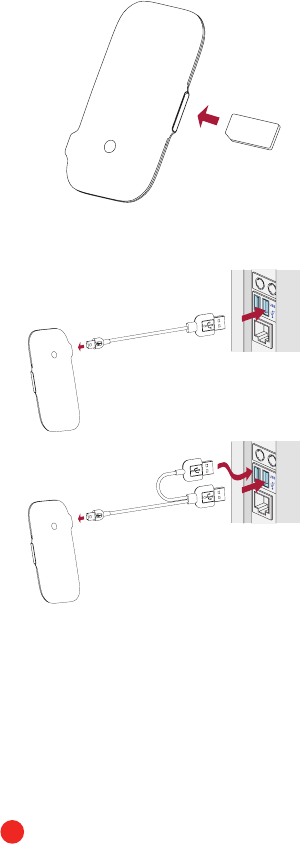
3
Set up your Huawei E272
modem
Before you can start using your new
modem, you’ll need to set it up.
You will need to have an activated
Vodafone SIM card – this should have
been provided when the modem was
purchased.
Put the SIM card into the side of the
modem.
You should have been supplied with
two data cables – one short and
single-ended one, and one long and
double-ended. You only need to use the
double-ended cable if a single USB port
does not supply enough power (if it is a
USB-powered hub for example).
Plug the single end of the data cable
into the modem as shown.
Plug the other end into your
computer’s USB port – if this does
not power the modem, then use the
double-ended cable.
This should automatically start
the software – see next page.
•
•
•
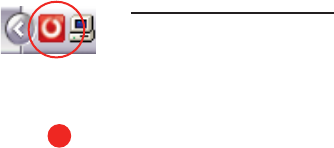
4
For other versions of Windows
If you have an earlier version of
Windows®, then you may need to select
the start-up program using the fi le
explorer:
This is on the drive called Vodafone
Mobile Connect Lite.
The startup program is called
VMC_PBStarter.exe.
For Mac OS X systems
If you’re using Mac OS X 10.3.5 or
higher, you will need to install the
software from the CD-ROM (if provided),
or download it from the Support section
of www.support.vodafone.com.
•
•
Run the software
For Microsoft® Windows Vista™
(32/64 bit) or Windows® XP systems
If your computer is running Microsoft
Windows Vista or Windows XP, it should
automatically start the driver setup
process (your modem already contains
the software needed). This could take
a few minutes to complete. Then it will
start the Vodafone Mobile Connect Lite
software.
You’ll now see a license agreement
screen.
Agree to the licence agreement.
You’ll then see a new icon appear in
the bottom right of your
screen. If you need to start
Vodafone Mobile Connect
Lite again, just double-click
on the icon.
•
•
•
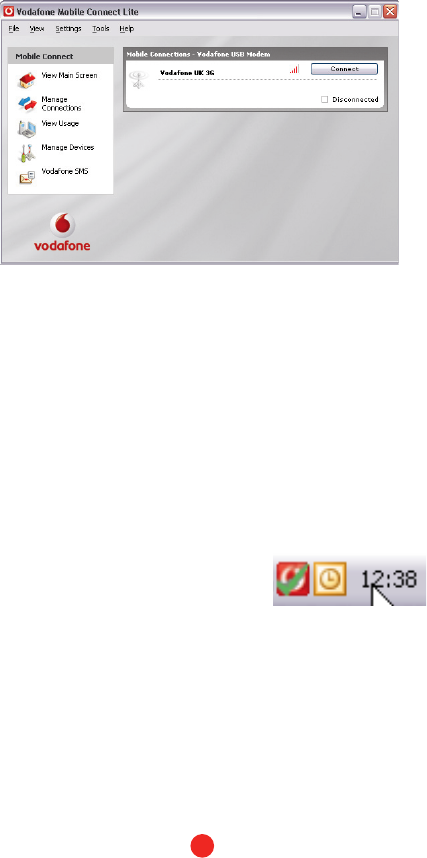
5
Confi guration
The fi rst time you run Vodafone
Mobile Connect Lite, your modem will
usually be set as the default device
automatically.
If this is not the case, you will need to
select your data modem as the device
you want to use (you may have other
devices connected to your computer).
Click Manage Devices in the main
screen, then select the Mobile
Connect Modem (it may be called the
Huawei E272).
Select the Default check box.
Click OK.
•
•
•
The software will then check with the
modem that everything is OK, and then
you’ll see the main window appear, with
a Connect button enabled.
A green tick will be displayed on top
of the icon in the bottom right-hand
corner of your screen. This indicates
the modem is ready to connect.
•
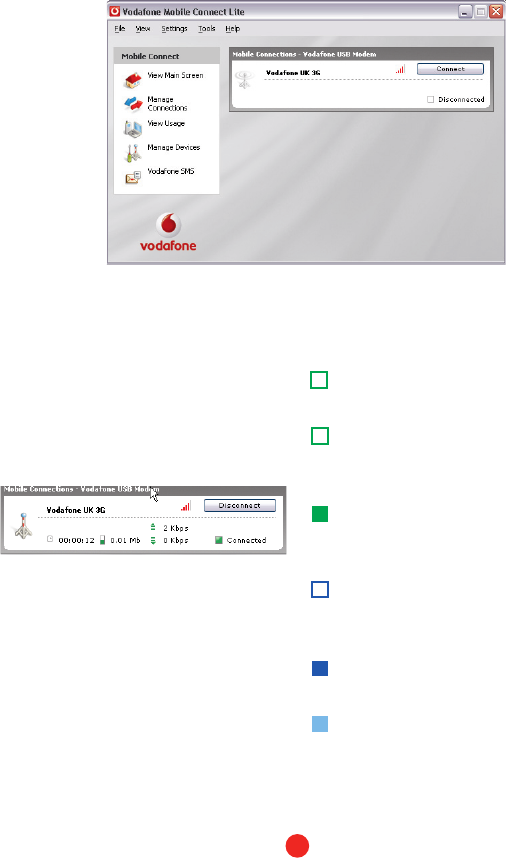
6
Make a connection
Simply click on the Connect button
to open a data connection. The main
window will now show your connection
status and other information.
You should now be able to use your
usual web browser and email programs.
To close the connection, click
Disconnect.
Modem status
The red strip LED will show if data is
being transmitted. If it glows steadily
then no data is being transmitted. As
data is transmitted it will alternatively
glow and fade (breathing effect).
Your modem will also show the signal
status using the LED light on the side:
Green double blinking: Power on,
searching for network.
Green blinking: A GPRS network has
been found, and the modem is ready
to connect.
Green solid: Connected to a GPRS
network – data being sent and
received.
Blue blinking: A 3G network has
been found, and the modem is ready
to connect.
Blue solid: Connected to a 3G
network.
Light blue solid: Connected to a 3G
Broadband network.

7
Other settings
You can customise the way the
software operates using the menus.
In Settings you can select a new
language, or whether you’d like the
software to start automatically when
Windows starts.
In Manage Connections you can
choose whether Vodafone Mobile
Connect Lite connects automatically
when it detects that your modem has
been plugged into your computer
•
•
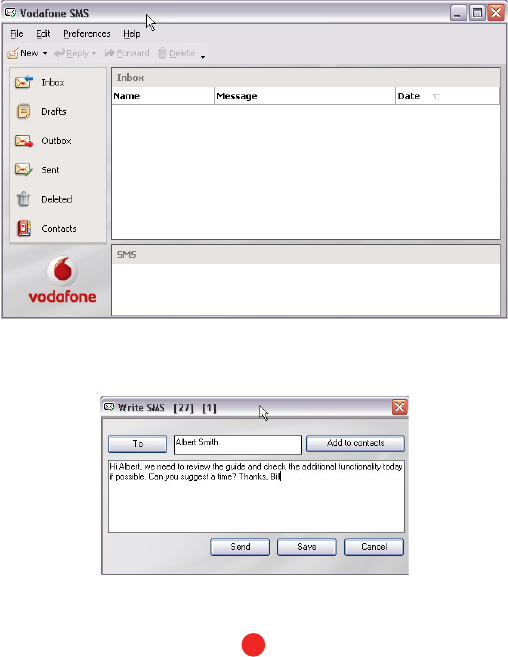
8
Use SMS Text Messaging and
Contact Management
With the Vodafone Mobile Connect Lite software you can receive and send SMS
(Short Message Service) text messages to and from your computer. The program
provides you with an easy way to view messages you have received, write new
messages, and manage contact details for frequently-used SMS numbers.
Send an SMS
Click Vodafone SMS on the navigation bar – on the left-hand side of the main
window – to open Vodafone SMS.
Click New at the left-hand end of the SMS toolbar to create a new SMS text
message.
After your SMS has been sent, it will be stored in the Sent list.
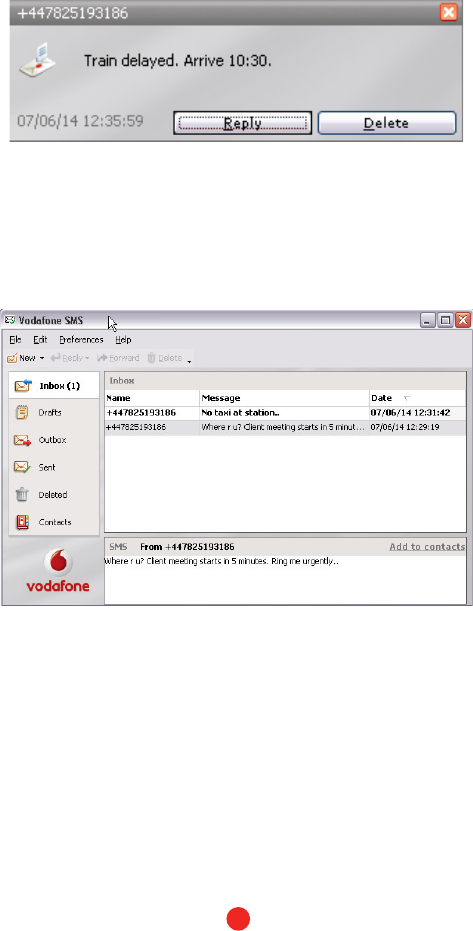
9
Receive an SMS
When you receive an SMS while connected to the Vodafone network, a pop-up
window will briefl y appear at the bottom right-hand corner of the screen, allowing
you to read the message and respond to it. The received message can also be read
from the Inbox on the main Vodafone SMS window.
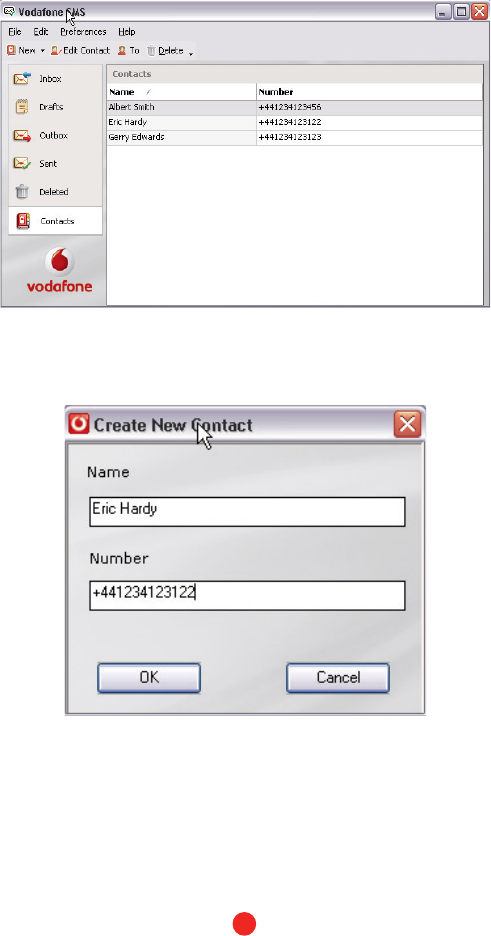
10
Manage SMS Contacts
On the left-hand side of the Vodafone SMS window is the SMS navigation
bar. Click Contacts on the SMS navigation bar to open the Contacts list, in
which you can manage names and numbers that you use frequently.
Clicking the New button on the SMS toolbar opens a new contact window.
Enter the name and number of your contact, using the international format
for the number, e.g. +447774477000.

11
Troubleshooting
If nothing happens when you plug
the modem into your computer, try
using another USB port.
If you don’t see your modem in
the list of devices, try removing
the USB cable and restarting your
computer. Then re-attach the cable
and let Vodafone Mobile Connect Lite
restart.
If you can’t make a data connection,
make sure that your SIM is enabled
for data connections. Contact
Support if you’re not sure.
If you get an error message: Error:
you must be on the Vodafone
network to make a connection,
please check that you are using a
Vodafone SIM card. You can only use
Vodafone Mobile Connect Lite with
Vodafone operators.
For any other problems, fi rst try the
Help menu in the Vodafone Mobile
Connect Lite main screen.
•
•
•
•
•
Support
For further help, please visit
www.support.vodafone.com, or call
Vodafone Support on 191 or
08700 700 191.

12


© Vodafone 2007. Vodafone and the Vodafone
logos are trade marks of the Vodafone Group.
Any product or company names mentioned
herein may be the trade marks of their
respective owners. Product Code:
e272 VMCLite 3.0.3 09/2007_en_UK
1
Safety Information
Please read the safety information carefully to
ensure the correct and safe use of your wireless
device.
General Recommendations
for Use
Always handle your wireless device with care
and keep it in a clean and dust-free place. Do
not expose your wireless device to open flames
or lit tobacco products.
y Always keep your wireless device dry.
y Do not drop, throw or try to bend your
wireless device.
y Do not paint or scratch your wireless device.
y Do not attempt to disassemble your wireless
device. Doing so will void warranty. Only
authorized personnel are allowed to do so.
y Use approved accessories only. Do not
connect your wireless device to any
incompatible products.
Laws and Regulations
y Do not operate your wireless device where it
may be unsafe to do so or where you are
required not to do so.
y To deactivate your wireless device, stop all
applications using the wireless device first
and then remove the wireless device from
your PC.
y Obey all local laws, regulations, rules, orders,
signs and notices while using the wireless
device. Signs about the use of mobile phones
should also be obeyed as referring to other
wireless equipment including wireless
devices provided by Huawei.
Electronic Device
y Deactivate your wireless device near
high-precision electronic devices. The
wireless device may affect the performance
of these devices.
y Pacemaker manufacturers recommend that a
minimum separation of 15 cm be maintained
between a wireless device and a pacemaker to
avoid potential interference with the
pacemaker. Deactivate your wireless device,
if it may have disturbance to the pacemaker.
Deactivate in Explosive Areas
Deactivate your wireless device where the air is
potentially explosive. It is rare, but your PC
could generate sparks.
Deactivate in Blasting Areas
Deactivate your wireless device where blasting
is in progress. Remote-controlled radio
frequency (RF) devices are often used at
construction sites to set off blasting.
2
Deactivate in Aircrafts
Deactivate your wireless device before
boarding or in any aircraft. Wireless devices
can cause interference in aircrafts.
Deactivate at Hospitals
Obey regulations or rules at hospitals.
Deactivate your wireless device near medical
equipment. Wireless devices can cause
interference to cardiac pacemakers, implanted
defibrillators or other medical equipment.
Deactivate near Hearing
Devices
Deactivate your wireless device near hearing
devices. People with hearing aids may
experience interfering noise near wireless
devices.
Recommendations for
Children
Do not allow children to play with your
wireless device. They could hurt themselves or
others, or could accidentally damage the
wireless device. Your wireless device contains
small parts with sharp edges that may cause an
injury or a choking hazard.
Deactivate While Driving
Do not use the wireless device while driving.
Immunity to Interference
Your wireless device is immune to interferences
caused by audible signals.
Cleaning and Maintenance
y Before you clean or maintain the wireless
device, stop all applications using the
wireless device and remove your wireless
device from your PC.
y Clean your wireless device with a piece of
soft antistatic cloth.
y If the wireless device or any of its accessories
does not work, turn to an authorized service
center for help.
Environmental Protection
Observe the local regulations regarding the
disposal of your packaging materials, old
wireless device and its accessories. Please
promote their recycling.
SIM/USIM Cards
While inserting or removing the SIM card,
protect yourself against electrostatic discharge
(ESD). Do not touch the connector of the SIM
card. As a precaution, always make sure that
the wireless device is already in your hand
before you insert or remove the SIM card.
Restart on ESDs
Software will attempt to re-initialize a
3
connection once a substantial electrostatic
discharge causes the device to reset. If the
software is not operational after an ESD, restart
the software application.
Agency/Regulatory
Information
The wireless device is approved for use in
many regions of the world. In these regions, the
device meets all radio frequency exposure
requirements. The following approvals and
notices apply in specific regions as noted.
CE Approval (European
Union)
y The wireless device is approved to be used in
the member states of the EU. Huawei
declares that the wireless device is in
compliance with the essential requirements
and other relevant provisions of the Radio
and Telecommunications Terminal
Equipment Directive 1999/5/EC (R&TTE
Directive).
y Please observe the national local regulations
in the location where product is to be used.
This product may be restricted for use in
some or all countries of European Union
Radio Frequency Exposure
A separation distance of at least 20 cm
must be kept between the antenna used for this
transmitter and all persons.
* The general public RF exposure limits
referenced in the R&TTE Directive are
consistent with the published Guidelines of the
International Commission on Non-Ionizing
Radiation Protection (ICNIRP) 1998. ICNIRP
is a formally recognized non-governmental
organization in Non-Ionising Radiation
Protection for the World Health Organisation
(WHO), the International Labour Organisation
(ILO) and the European Union (EU). For more
information, visit the ICNIRP website at
www.icnirp.de.
Certification Information
(SAR)
THIS DEVICE MEETS THE
GOVERNMENT'S REQUIREMENTS FOR
EXPOSURE TO RADIO FREQUENCY
ELECTROMAGNETIC FIELD.
Your wireless device is a low-power radio
transmitter and receiver. When it is running, it
emits low levels of radio frequency energy
(also known as radio waves or radio frequency
fields).
Governments around the world have adopted
comprehensive international safety guidelines,
developed by scientific organizations, e.g.
ICNIRP (International Commission on
Non-Ionizing Radiation Protection) and IEEE
4
(Institute of Electrical and Electronics
Engineers Inc.), through periodic and thorough
evaluation of scientific studies. These
guidelines establish permitted levels of radio
wave exposure for the public. The levels
include a safety margin designed to assure the
safety of all persons, regardless of age and
health, and to account for any variations in
measurements.
Specific Absorption Rate (SAR) is the unit of
measurement for the amount of radio frequency
energy absorbed by the body when you use a
wireless device. The SAR value is determined
at the highest certified power level in
laboratory conditions, but the actual SAR level
of the wireless device while operating can be
well below the value. This is because the
wireless device is designed to use the minimum
power required to reach the network.
All models of Huawei's wireless device are
designed to meet radio frequency exposure
guidelines such as European Council
Recommendation and Federal Communications
Commission Notice (United States).
European Council Recommendation: Before
a wireless device model is available for sale to
the public, it must be tested according to the
technical standard-EN 50361 and not exceed
the limit established by the European Council
Recommendation: 1999/519/EC for safe
exposure.
The SAR limit adopted by the 1999/519/EC is
2.0 watts/kilogram (W/kg) averaged over ten
gram of tissue. The highest SAR value for this
device type when tested is 0.925 W/kg.
[EN 50361 scope states "This basic standard
applies to any electromagnetic field (EM)
transmitting devices intended to be used with
the radiating part of the equipment in close
proximity to the human ear including mobile
phones, cordless phones, etc. The frequency
range is 300 MHz to 3 GHz. Therefore, the
above text does not address primary use of the
wireless device product.]
Federal Communications Commission
Notice (United States): Before a wireless
device model is available for sale to the public,
it must be tested and certified to the FCC that it
does not exceed the limit established by the
government-adopted requirement for safe
exposure.
FCC Statement
This device complies with Part 15 of the FCC
Rules. Operation is subject to the following two
conditions: (1) this device may not cause
harmful interference, and (2) this device must
accept any interference received, including
interference that may cause undesired
operation.
5
Class B Digital Device
This equipment has been tested and found to
comply with the limits for a Class B digital
device, pursuant to Part 15 of the FCC Rules.
These limits are designed to provide reasonable
protection against harmful interference in a
residential installation. This equipment
generates, uses and can radiate radio frequency
energy and, if not installed and used in
accordance with the instructions, may cause
harmful interference to radio communications.
However, there is no guarantee that interference
will not occur in a particular installation.
If this equipment does cause harmful
interference to radio or television reception,
which can be determined by turning the
equipment off and on, the user is encouraged to
try to correct the interference by one or more of
the following measures:
y Reorient or relocate the receiving antenna.
y Increase the separation between the
equipment and receiver.
y Connect the equipment into an outlet on a
circuit different from that to which the
receiver is connected.
y Consult the dealer or an experienced
radio/TV technician for help.
HSUPA Statement
This device does not support high speed uplink
packet access (HSUPA) at the following
frequency bands:
y UMTS FDD Band II
y UMTS FDD Band V
Version: V100R001_02 Part Number: 31220678